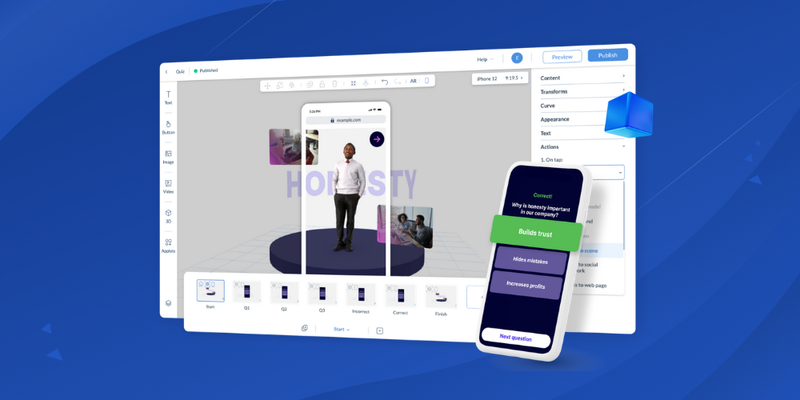In today's rapidly evolving business landscape, the modern workforce faces unique challenges: they're often busy, under-resourced, and spread across the globe. Traditional training methods are no longer sufficient. Enter Augmented Reality (AR)—a game-changer in learning and development (L&D), offering unparalleled engagement, interactivity, and impact, especially for remote workers.
Why AR for Learning?
Simply put, AR increases engagement and memory retention in your learning solutions…
This is backed up by our groundbreaking research, including the 'Layered' study conducted with Mindshare and Neuro-Insight, reveals the profound impact of AR on learning. This study found a significant increase in retention, emotional response, and memory encoding when AR is used compared to traditional methods. Specifically, AR almost doubled visual attention and increased memory encoding by 70%. This means AR-enhanced L&D programs are not only more effective in knowledge retention but also reduce the need for frequent retraining.
How AR can help you achieve your objectives
Reduce costs & time to competency
AR offers a practical and effective way to deliver active learning through doing, aiding attention and memory recall to drive efficiencies and effectiveness in your L&D programs. The easier it is for your workforce to recall the training the less time they have to spend going over it. AR can be relatively simple to build and by its nature, it’s easily scalable and cost-effective . From one central point, you can design an interactive program that doesn’t need a wealth of physical material or manpower.
Prove Return on Investment (ROI) with real-time data & actionable analytics
ROI is one of the final indicators of success for any project. At times, it can be difficult to calculate for L&D; how do you measure the success of a skill?
With AR, L&D practitioners can easily show the success rate of people who completed the task and were tested successfully. These rates can then be shown to management, indicating the success of a project. Professionals can keep an eye on the stats as they happen, from the number of times people repeat a task, to how long they spend reading a specific page. As they happen in real time, teams can get an instant insight into the success of their work.
The data can then be used to provide actionable analytics. Let’s say a team member goes through one task fully, but not another. The team can identify pain points with the process, and then tackle them immediately to improve it. In a classroom, stats like these are not accessible, as it is difficult to track the actions of everyone. But with AR, all interactions are tracked.
If you are creating your learning content using Zapworks Designer, you have the convenient option to export SCORM packages*. These packages can then be uploaded to your current Learning Management System (LMS). By doing so, you are able to analyze learner completion data and tie that back to a learner profile. This integration provides you with the opportunity to gain a comprehensive understanding of your learners' progress and performance, allowing for effective evaluation and improvement of your learning experiences.
*currently available in beta
Predict workforce trends
This data can then be used to predict workforce trends. If particular classes are being taken more regularly, this indicates a demand for said skill. It could mean more new hires may be needed, or the course itself should be updated to better reflect the work it is contributing towards. In any case, practitioners can access the information and use it to improve their work – something which other learning systems cannot provide.
No matter what emerging technologies impact the industry, there is one trend that can be predicted with certainty: the use of data. Data provides the bedrock which influences all L&D programs, give insights on how people perform and where elements can be improved.
6 ways AR can enhance your learning solutions
Incorporating AR into your training improves the learning experience, letting people choose their own approach to learning with the resources provided, as well as facilitating remote learning. Training can also take less time and be more flexible; instead of a scheduled appointment, a training experience can be rolled out at any time to upskill employees to a necessary level. If designed well, it can provide an engaging experience that pulls people in, leading to a greater impact on the business and individual.
Enhancing your existing learning solutions
Paper-based learning
A switch to AR doesn't call for throwing out your entire program, quite the opposite. AR can be integrated with paper-based learning materials, such as posters or textbooks to provide additional interactive content, enhancing the learning experience.
Why not try…
Taking your health and safety posters to the next level, helping your employees visualize the escape routes and even test them on their understanding.
E-learning courses
Likewise, AR can be easily integrated into your existing eLearning and microlearning courses via a simple link or QR code. Using AR means your learners are no longer confined to monotonous 2D videos or slide presentations. Instead, learners can interact with 3D content for deeper engagement, overlay information on real-world scenarios for greater context, or undertake practical simulations in real-time.
Why not try…
Adding interactive soft skills simulations to your management training courses to help your new managers practice the communications skills they will need to help their team learn and progress.
Creating learner-centric training
A one-size-fits-all learning approach is not an effective way to train. People are individuals who each learn in different ways and at a different pace. AR enables you to create a program that can be tailored to fit the needs of individuals in a simple and cost-effective way. By giving users interactive AR learning materials, you can create branching scenarios where learners can ‘choose their own adventure’, empowering them to control their own learning journey.
Why not try…
Creating personalized AR dashboards for your employees with a range of modules they can choose based on their interests and existing skills and complete in their own time.
Providing contextual learning with real-world application
AR is ideal for providing real-time information based on the environment. Whether it's providing information for new starters as part of the onboarding process or vital health and safety procedures. Having the information accessible at the point of need is invaluable. Part of the benefit of this contextual learning is the ability to facilitate real-world application. AR allows learners to apply their knowledge in real-world contexts immediately.
Why not try…
Providing just-in-time learning for your office IT equipment, allowing your employees to access information or guidance through 3D models or video right at the moment of need.
Delivering flexible and collaborative learning
AR enables your workforce to access and engage with different materials from different locations, by allowing people to access the content when it suits them, and therefore when they are most engaged. The flexibility of AR platforms like Zapworks also means you can update messaging and experiences to fit with changing guidelines, policies and procedures. The flexibility AR provides is great at facilitating collaborative learning experiences from various locations, where multiple users can interact with the same augmented content simultaneously, promoting discussion and collaborative problem-solving.
Why not try…
Creating a virtual collaborative learning space where your employees can work together on projects or learn new skills.
Increasing learner engagement
Effective interactivity is something that traditional remote learning materials can lack. A book or leaflet can provide information – but it can’t answer questions or elaborate on specific points. The same goes for a video; while it’s a great way to deliver visual information, it lacks interactivity and immersion.
Instructor-led training will always be impactful, as long as participants have the room to engage and be inquisitive. We do not suggest that this will ever change, what we do suggest is that AR can help elevate the remote learning experience and make it more engaging. The use of alpha video for example can stream a full instructor-led lesson, accessible whenever and wherever the user needs.
Why not try…
Breaking down your existing instructor-led training into bitesize alpha videos that can be accessed after the session as refresher material.
Final Thoughts
The integration of Augmented Reality (AR) into your learning solutions is not just an innovative step; it's a necessary evolution in today's changing business environment. The proven benefits of increased retention, engagement, and practical application make AR an asset in any L&D strategy. By enhancing existing learning materials with AR, offering flexible, collaborative, and contextual learning experiences, and leveraging data to predict and respond to workforce trends, companies can significantly boost their training effectiveness. Adopting AR in your L&D programs is more than just keeping up with technology—it's about creating an immersive, and efficient learning environment that drives both individual and organizational growth.
 Grace Vassallo
Grace VassalloSenior Brand & Marketing Manager, Zappar
